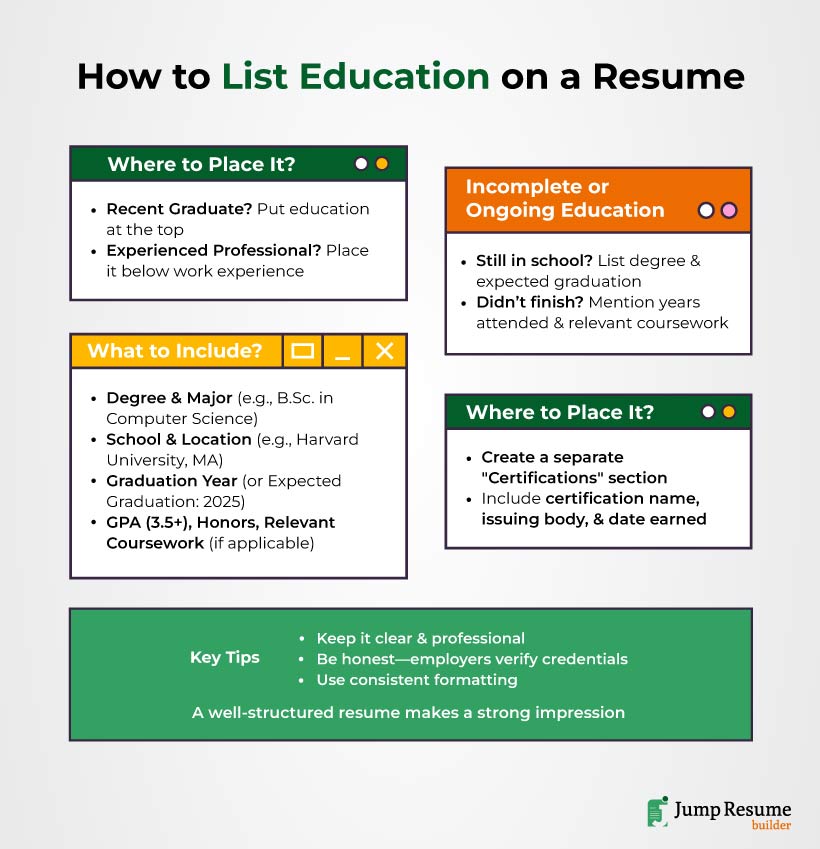Employers look at your education section to assess your qualifications and background. A well-structured education section can highlight your expertise, relevant coursework, and certifications, making your resume stand out.
If you’re a recent graduate, your education should be at the top of your resume to highlight your academic achievements.
However, if you have relevant work experience, list it after your job history to prioritize practical skills. Always include your degree, school name, and graduation year. If you have a GPA of 3.5 or higher, consider adding it to showcase strong academic performance.
Structuring this section properly ensures employers quickly see your most relevant qualifications.
You can also include awards or honors to highlight achievements. If you are still in school, write “Expected Graduation” with the year. On the other hand, if you did not finish, list the years attended.
Furthermore, if you have certifications, add them in a separate section.
Make sure to include the name, organization, and date earned. Moreover, keep your education section neat and easy to read. Finally, a well-organized resume helps you stand out and increases your chances of getting hired.
Placing your education section correctly can make a big difference in how employers perceive your qualifications. In this blog, we’ll cover the best placement strategies based on your experience level and tips to highlight your credentials effectively.
Where to Place the Education Section on Your Resume
Your education section is an important part of your resume. It tells employers about your background and skills. However, many people do not know where to place it. The right placement depends on how much work experience you have.
If you are a recent graduate, put your education section at the top. This is because you may not have much job experience yet. By listing education first, you show your academic achievements. You can also add honors, awards, and relevant courses to highlight your skills.
Education Placement for Experienced Professionals
If you have work experience, list your education section below your job history. Employers care more about your work skills when you have been working for many years. This way, they will see your job experience first before looking at your education.
In short, always organize your resume in a way that shows your strengths. A well-structured resume helps you make a good impression.
What Details to Include in the Education Section
If your degree is directly related to the job you’re applying for, consider adding relevant coursework, honors, or certifications to strengthen your qualifications.
First, you should include the degree you earned, such as a Bachelor’s, Master’s, or Associate’s degree. Next, list your major or field of study, like Computer Science or Business Administration. After that, write the name of your school and its location.
It is also important to add the year you graduated.
If you are still in school, mention your expected graduation year. Additionally, if your GPA is 3.5 or higher, you may include it. You can also list any honors, such as Magna Cum Laude or being on the Dean’s List.
Furthermore, if you are applying for an entry-level job, you can include relevant coursework to show your knowledge in the field. By organizing your education section properly, you help employers understand your qualifications and improve your chances of getting hired.
Suggested Read: How to Make a Resume: Step-by-Step Writing Guide for 2025
How to List Incomplete or Ongoing Education
If you’re still in school, be sure to highlight it on your resume. You can write the degree you are working on and your expected graduation year. For example, you can say, “Bachelor of Science in Biology, Expected Graduation: 2025.” This helps employers know that you are still studying and will finish soon.
If you started college but did not finish, you should still list it on your resume. First, write the name of the school and the years you attended. Then, you can mention the degree you were working on. If you took important courses related to the job, you can list them under “Completed Coursework.” This shows that you have learned valuable skills even if you did not graduate.
By listing your education this way, you stay honest while highlighting your knowledge. A clear and well-organized resume helps employers see your strengths.
Handling Multiple Degrees and Certifications
When listing multiple degrees on your resume, always start with the most recent one.
This helps employers see your latest education first. For example, if you have a master’s degree and a bachelor’s degree, list the master’s degree first. Be sure to include the degree name, school name, and graduation year.
If you also have certifications, list them in a separate section called “Certifications.”
This makes your resume clear and easy to read. Certifications should include the certification name, the organization that issued it, and the date earned. For example, if you have a Project Management Professional (PMP) certification, write the name, issuing organization, and the date it was received.
Keeping your education and certifications in separate sections helps employers quickly find important details.
When your resume is neat and well-organized, it looks professional and leaves a strong first impression. This makes it easier for employers to understand your qualifications and see you as a good candidate for the job.
Research on resume impressions shows that the way you present your education, experience, and personal qualities affects how employers see you. In this study, business professionals reviewed different types of resumes to understand what makes an applicant stand out. The results showed that when education was relevant to the job, employers believed the applicant was more skilled, had more potential, and deserved a higher salary.
Similarly, when job experience matched the role, employers saw the applicant as more confident, capable, and trustworthy. In addition, the way applicants described themselves also made a big difference. When they used positive words to highlight their strengths, employers thought they had better social skills, greater confidence, and a higher chance of being hired.
This means that not only is the content of your resume important, but the way you present it can also affect your job opportunities.
By organizing your resume properly and choosing the right words, you can make a strong impression on employers and improve your chances of getting hired.
Listing Certifications and Licenses Correctly
When adding certifications and licenses to your resume, it is important to list them clearly.
First, create a separate section called “Certifications” or “Licenses.” This helps employers find them easily. Next, write the full name of each certification or license. After that, include the name of the organization that gave it to you.
Additionally, please specify the date on which you received it.
If the certification has an expiration date, make sure to include that too. This way, employers will know if it is still valid. Keeping this section organized makes your resume look professional. Certifications and licenses show that you have special skills for the job.
They also help you stand out from other job seekers. By following these steps, you make it easier for employers to see your qualifications. A well-organized resume gives you a better chance of getting hired.
How to Address Gaps in Education
If you have gaps in your education, you should explain them in a clear way.
If you took time off to work, volunteer, or serve in the military, include that experience in your resume. This shows that you were still learning and gaining skills. Additionally, prepare to discuss these gaps in your cover letter or during an interview.
Employers like to see that you used your time well.
Formatting and Consistency Matter
Your education section should be clear and easy to read.
Use the same font, spacing, and style to keep it neat.
Adding bullet points or line breaks can help employers find important details quickly. A well-organized resume looks more professional and helps you stand out. Today, jobs are changing very fast.
Many people lost their jobs because of the COVID-19 pandemic and new AI tools.
Some of these jobs may never come back. Hidden unemployment is a bigger problem than we realize. In the future, AI tools like Generative Pretrained Transformer (GPT) will make it even harder for some workers to find jobs.
Businesses will face challenges, and many jobs will disappear. To solve this problem, people need to learn new skills quickly.
The Efficient Resume-Based Re-Education for Career Recommendation in Rapidly Evolving Job Markets study highlights the potential of AI in career transitions.
By leveraging deep learning and natural language processing, Career-gAIde provides personalized job recommendations and skill-learning pathways, helping professionals navigate evolving job markets.
While its current focus is on software engineering, the underlying principles have broader applications across various industries.
As AI-driven career guidance systems continue to develop, they could play a crucial role in workforce adaptability, ensuring individuals stay competitive and find better job opportunities in the future.
Should You Include High School Education?
If you have a college degree, you do not need to list your high school. However, if high school is your highest level of education, you should include it. You can add any honors or important coursework.

How to List Online Degrees or Courses
Online degrees and courses should be listed just like traditional ones. Write the school name and completion date. If needed, you can mention that it was an “Online Program.” This is helpful if the school is well-known.
Example:
University of California, Berkeley
Bachelor of Science in Business Administration (Online Program)
Completed: May 2023
Avoiding Common Mistakes
Many people make mistakes when listing education.
Do not include outdated or unnecessary details, like high school if you have a college degree. Always be honest about your degrees and graduation dates because employers check this information.
Lastly, keep your education section short and clear so employers can read it quickly. A well-organized resume helps you make a good impression!
Suggested read: Resume Layout: Examples and Best How-To Tips
Final Thoughts: Listing Education on a Resume
Organize your education section properly to help hiring managers quickly understand your qualifications.
If you are a recent graduate, listing your education clearly shows your skills and knowledge. On the other hand, if you are an experienced professional, structuring this section will highlight your academic background without taking focus away from your work experience.
Using the correct format makes your resume look professional and easy to read. This way, your education supports your job application and helps you make a strong impression. To ensure your resume is well-structured and impactful, Create Your Resume with our professional resume builder today.




